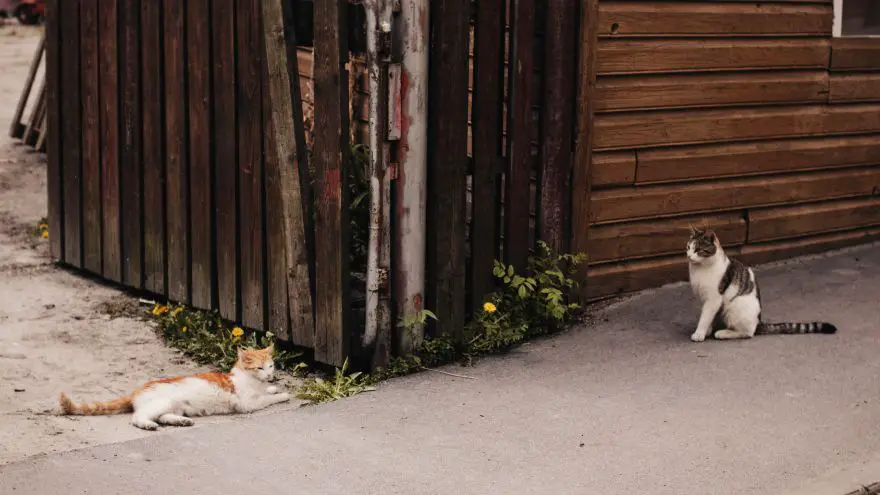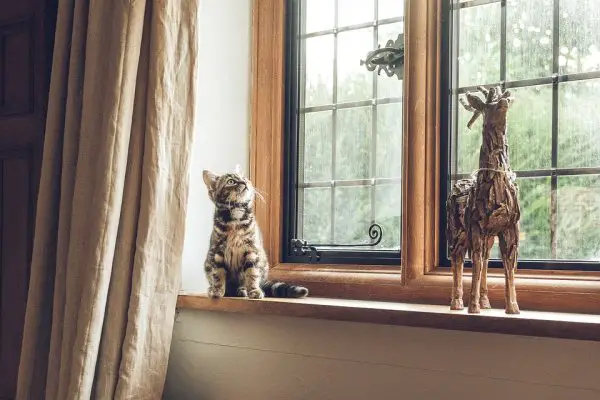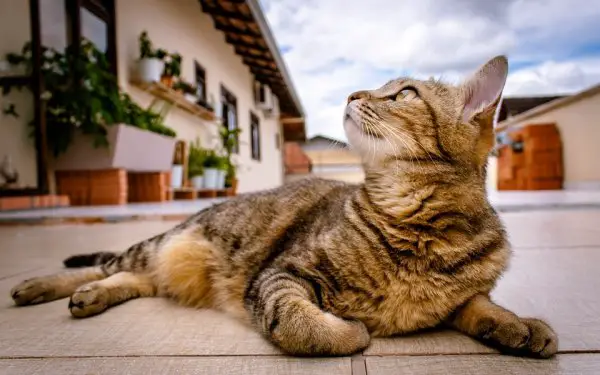Should You Let Your New Feline Become an Outdoor Cat?
 Should You Let Your New Feline Become an Outdoor Cat?
thegearhunt.com
Should You Let Your New Feline Become an Outdoor Cat?
thegearhunt.com
You have finally gone down to the local shelter and found the perfect kitty to add to your family and then you and your family adopted her as your very own. Now, you are home and in the middle of getting her settled with her litter box, food and water dishes, and toys, you are debating with yourself whether to let her go outside when she wants too or keep her as strictly an indoor cat. While we all see the cats roaming the neighborhoods, and have been told that it’s cruel to keep a cat inside forever, there is substantial evidence to support doing just that. There are many myths surrounding indoor cats that need to be dispelled and we will go into them in this blog.
 There is a great debate among cat owners, with half of the side of letting their feline pals go outdoors whenever they please and the other half falling squarely on the side of the fence that keeps their cats inside, never to set a foot on the ground outside. Who’s to say who is right and who is wrong? There are pros and cons to both, and in the end, you have to make the decision you feel is right for you and your new kitten. I, myself love cats and have quite a few, some that have taken up around the house and haven’t left and others that are inside cats. Whatever you decide, you have to be comfortable with your choice and take precautions to make sure your new cat is healthy, happy, safe, and above all loved.
There is a great debate among cat owners, with half of the side of letting their feline pals go outdoors whenever they please and the other half falling squarely on the side of the fence that keeps their cats inside, never to set a foot on the ground outside. Who’s to say who is right and who is wrong? There are pros and cons to both, and in the end, you have to make the decision you feel is right for you and your new kitten. I, myself love cats and have quite a few, some that have taken up around the house and haven’t left and others that are inside cats. Whatever you decide, you have to be comfortable with your choice and take precautions to make sure your new cat is healthy, happy, safe, and above all loved.
In this blog, we will go into the myths associated with indoor cats, the reasons you shouldn’t just let your indoor cat go outside, how to keep them safe if you feel you need to, the pros and cons of doing so, and even a few tips on how to find your feline if they get out of the house and disappear. Oh, and don’t forget the dangers to outside cats. We will discuss it all here, to help you make the decision of whether you should let your new feline become an outdoor cat. Ready to delve into this topic? Then, follow me.
Myths Surrounding Indoor Cats Dispelled
There are many myths that surround indoor cats that make their owners feel they are being cruel to not let them outside. First, we will go into these myths and debunk them, one at a time.
Myth Number One: Indoor Cats Become Bored
This one is a fact, indoor cats do get bored, but that doesn’t mean you should let them outside to roam. The best solution to this problem is to make your home interesting for your new little addition to the family. For example, set up perches in certain windows where your pal can watch the birds and if you think your cat will go for it, adopt a second kitten, so she has someone to play with.
Myth Number Two: Indoor Cats Destroy Things
While indoor cats can be destructive, there is usually a reason behind that destruction. If your usually tame and docile cat suddenly starts ripping your couch to shreds or clawing at the walls, maybe it’s time to reexamine her situation. Perhaps, she doesn’t like her scratching post or she has outgrown it. Try getting her a new one and see if that stops the problem. It’s a better solution than turning her outside where anything can happen.
Myth Number Three: Indoor Cats Become Obese
It is possible for any cat to be overweight if they are fed too much. If your cat is becoming a little too big for your liking and you are becoming concerned, then make sure to feed her at set times of the day. Cats are creatures of habit and love schedules. If you have a cat that constantly meows when the food bowl is empty, or even if they can see the bottom, then trying stuffing a Kong with their food so they have to work to get it, and have fun playing at the same time. Just because your cat is allowed outside, doesn’t mean she will not be overweight.

Myth Number Four: Cats Who have Been Outside can no Longer be Strictly Indoor Cats
This one is not true. Many cats have gone from being outdoor to indoor cats with no problem. The trick is once again to keep the indoors interesting for your cat, so she won’t bolt everytime the door is opened.
Myth Number Five: Cats Are Safe Outside as Long as They Stay Close to Home
Not true, cats can get into just as much trouble close to home, as they can far away from home. Studies show that house cats will roam over 20 acres away from home on a given night, so anything could happen when you let your feline pal out that front door.
Now that we have dispelled the myths about indoor cats and letting them outside when they want to go, let’s delve into the debate that rages strong between cat owners and look at the pros and cons of indoor vs outdoor cats.
Top Benefits of Letting Your Cat Roam
The debate for letting your cat roam can be a convincing one, so we will get the benefits of letting your cat be an outdoor cat out of the way first.
More Physical Activity
It’s a fact that outdoor cats do have more ability to run and be physical. Whether it’s climbing trees or simply exploring. Cats that roam more in an outdoor area typically get more exercise and often weigh less than cats who are kept indoors do.

More of an Opportunity to Explore
Being an outdoor cat gives your kitten more of a chance to explore the world around her, something that cats have been doing since the beginning of time. It gives them more of a chance to follow their natural instincts.
Keeps Them Free to Engage in Instinctive Behavior
The one thing that most indoor cat owners have the biggest problem with is their cat scratching up their walls and furniture. Outdoor cats have free rein to scratch the trees and anything else they can find on the outside, saving your furniture and walls on the inside.
The Litter Box Stays Fresher
If your beloved cat is outside for the majority of the time, then they have the whole world as their litter box, meaning the litter box on the inside stays fresh and needs to be changed less often.
Disadvantages, Dangers of Letting Your Cat Roam
Now, that we know the advantages of letting your new cat into the outdoors, let’s examine the disadvantages, actually the dangers of letting your cat outside to roam the yard and neighborhood.
Being Hit by a Car
One of the biggest dangers of letting your cat roam the outdoors is the risk of being hit by a car. Just because you live on a quiet country road, still doesn’t mean your cat can’t be surprised by a car and injured or even worse. Whether you live in the country or on a busy city street, cars and cats don’t mix.
Hiding Under the Hood
Cats enjoy curling up in dark, out of the way places, which means your cat is at risk of being killed by the fan motor when you crank up your car in the mornings. They like to hide under the hood, and if you don’t know they are there, the worst can happen quite easily.
They could Wander to Far
There are many, many times that an indoor cat gets outside and wanders too far, never to be seen again. Cats get lost too you know.
Other Animals
According to where you live, it is possible that your cat could be attacked by foxes, raccoons, and dogs. It’s also highly possible that your cat could get in a fight with an aggressive bigger cat that could seriously hurt her.
Other Dangers to Outdoor Cats
- More apt to catch infectious diseases, such as upper respiratory infections and feline aids
- More apt to get into toxic substances such as antifreeze or poisons
- Can easily get trapped in someone else’s shed or garage
- Could be stolen
- More apt to pick up fleas, ticks, worms, and other parasites
These are the pros and cons of letting your cat be an indoor and an outdoor cat. Please weigh them carefully, before you make your final decision with the new kitty, you just brought home to your family.
Tips for Protecting Your Feline Outside
If you have decided that your pet would benefit from outdoor time, read on below for a few tips to keep him safe and sound to come back indoors again.
- Provide your feline with an identification collar or a harness with an ID tag attached
- Don’t let them out before they are spayed or neutered and have all of their vaccinations
- Consider adding a bell to your cat’s collar, so people are alerted that they are around
- It’s also a good idea to leash train your cat, that way you can take them outside for walks and not have to worry about something happening to them while they are outdoors
These are just a few of the tips that can help you protect your new cat if you decide to let them go outside. Now, we will move into the portion of our blog that covers what to do if your indoor cat gets outside and goes missing.
Precautions to Take
It is a very likely possibility that your indoor cat is going to get out at some point in their lives. Taking the following precautions can make finding him a whole lot easier.
There is a debate over this one, but microchipping your cat is one way to ensure your cat is able to be found if they get out, become lost, and are alone and scared.
Keep a current photograph of your cat available. Not one of those cutesy shots you are always snapping, but one that is full body and shows what your cat looks like, so people can identify him and return him to his proper home when he is found.

Spread the Word
The first thing you will want to do is spread the word that your cat is missing. That means telling neighbors, friends, and anyone that will help find him about the problem. The more people who know that your cat is missing, the easier and more likely it will be to find her. Plaster her photo all over social media sites, as that has done a lot to help find missing animals in the past.
Check the Local Shelters
After you have spread the word and looked under your porch and around your neighborhood, it’s time to check the local shelters to see if someone might have brought the cat in or even if the pound has swooped her up. You can also ask the shelter to be on the lookout should someone bring in your cat and ask them to give you a call if someone does, as well.
Never Give Up
It’s important to never give up if your indoor cat suddenly becomes lost in the outdoors. It’s important to remember that this is a whole new world for her, and she is going to be alone, scared, and looking for you to find her. Try searching at night as well, since cats are nocturnal animals, she may be hiding during the day and coming out at night.
These are just a few of pros, cons, and dangers of letting your new indoor cat venture outdoors. The choice, of course, is one that each individual cat owner must make, but it helps to weigh everything before making your final decision.
Sources
- I Love Cats: 5 Things to do if Your Indoor Cat gets Lost Outside
- Petfinder: 6 Reasons You Might Let Your Cat Out and Why Not to
- Perfect Fit: Letting Your Cat Outside Versus Keeping Her Inside















